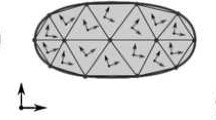Abstract
This paper is concerned with the extension of the minimal coordinates approach to flexible bodies. When using minimal coordinates, the number of configuration parameters corresponds exactly to the number of degrees of freedom and they can be chosen arbitrarily as far as there is a one-to-one relationship between the configuration of the system and the configuration parameters. In the rigid case, the equations of motion are obtained from the description of the translational and rotational motion of a frame attached to each body in terms of the chosen configuration parameters, and from the forces acting on each body. The extension to the simulation of flexible bodies naturally leads to a description of the motion of a flexible body from the one of its nodes. However, the relationship between the latter and the full internal motion of the body is not unique and is the subject of various developments. It was then proposed for the sake of generality to systematically treat flexible bodies as superelements, implemented according to the corotational approach, with a floating corotational frame. This allows to model any flexible body from its mass and stiffness matrices obtained from any available finite element code. Moreover, it doesn’t impose any restriction on the kinematics of the nodes which can then be expressed indifferently from absolute or relative coordinates as usually encountered with minimal coordinates. After a description of the adopted framework, the paper develops the equations of motion. Some test examples are presented, where the proposed approach will be compared to the ones obtained with the classical body reference frame approach and results from the literature. In some cases, the influence of the chosen corotational frame is analysed. The examples confirm that the corotational formulation should be restricted to flexible bodies involving only small deformations and rotational velocity. It is also shown that modelling can be adapted to improve the quality of the results.




















Similar content being viewed by others
Notes
While \(\boldsymbol{\mathrm{v}}\) denotes a vector specified by a magnitude, an orientation and a sense, \(\{\boldsymbol{\mathrm{v}}\}_{*}\) denotes the \(3\times1\) matrix gathering the coordinates of vector \(\boldsymbol{\mathrm{v}}\) in coordinate system *.
References
Schiehlen, W.: Multibody System Handbook. Springer, New York (1990)
Wehage, R., Haug, E.: Generalized coordinate partitioning for dimension reduction in analysis of constrained dynamic systems. J. Mech. Des. 104(1), 247–255 (1982)
Nikravesh, P.: Systematic reduction of multibody equations of motion to a minimal set. Int. J. Non-Linear Mech. 25(2–3), 143–151 (1990)
Wittenburg, J.: Dynamics of Multibody Systems. Springer, Berlin (2008)
Kim, S., Vanderploeg, M.: QR decomposition for state space representation of constrained mechanical dynamic systems. J. Mech. Transm. Autom. Des. 108(2), 183–188 (1986)
Singh, R., Likins, P.: Singular value decomposition for constrained dynamical systems. J. Appl. Mech. 52(4), 943–948 (1985)
Hiller, M., Kecskeméthy, A.: Dynamics of multibody systems with minimal coordinates. In: Pereira, M.F.O.S., Ambrosio, J.A.C. (eds.) Computer-Aided Analysis of Rigid and Flexible Mechanical Systems. NATO ASI, vol. 268, pp. 61–100. Kluwer Academic Publishers, Dordrecht (1994)
Blajer, W., Schiehlen, W., Schirm, W.: Dynamic analysis of constrained multibody systems using inverse kinematics. Mech. Mach. Theory 28(3), 397–405 (1993)
Hiller, M., Woernle, C.: Characteristic pair of joints—an effective approach for the inverse kinematic problem of robots. In: Proceedings of IEEE International Conference on Robotics and Automation, Philadelphia, USA, pp. 846–851 (1988)
Hiller, M., Kecskemethy, A.: Equations of motion of complex multibody systems using kinematical differentials. Trans. Can. Soc. Mech. Eng. 13(4), 113–121 (1990)
Verlinden, O., Ben Fékih, L., Kouroussis, G.: Symbolic generation of the kinematics of multibody systems in EasyDyn: from MuPAD to Xcas/Giac. Theor. Appl. Mech. Lett. 3, 013012 (2013)
Kouroussis, G., Verlinden, O., Rustin, C., Bombled, Q.: EasyDyn: multibody open-source framework for advanced research purposes. In: Proceedings (on CD) of the ECCOMAS Thematic Conference Multibody Dynamics, Brussels, Belgium (2011)
Masarati, P., Morandini, M., Mantegazza, P.: An efficient formulation for general-purpose multibody/multiphysics analysis. J. Comput. Nonlinear Dyn. 9(4), 041001 (2014)
Gerstmayr, J., Dorninger, A., Eder, R., Gruber, P., Reischl, D., Saxinger, M., Schörgenhumer, M., Humer, A., Nachbagauer, K., Pechstein, A., Vetyukov, Y.: HOTINT—a script language based framework for the simulation of multibody dynamics systems. In: Proceedings of the ASME Design Engineering Technical Conference, Portland, OR, vol. 7B (2013)
Ducobu, F., Rivière, E., Filippi, E.: Dynamic simulation of the micro-milling process including minimum chip thickness and size effect. Key Eng. Mater. 504, 1269–1274 (2012)
Huynh, H.N., Rivière-Lorphèvre, E., Verlinden, O.: Integration of machining simulation within a multibody framework: application to milling. In: Proceedings of the 4th Joint International Conference on Multibody System Dynamics IMSD, Canada (2016)
Wasfy, T., Noor, A.: Computational strategies for flexible multibody systems. Appl. Mech. Rev. 56(6), 553–613 (2003)
Ibrahimbegović, A., Mamouri, S.: On rigid components and joint constraints in nonlinear dynamics of flexible multibody systems employing 3D geometrically exact beam model. Comput. Methods Appl. Mech. Eng. 188(4), 805–831 (2000)
Jelenic, G., Crisfield, M.: Dynamic analysis of 3D beams with joints in presence of large rotations. Comput. Methods Appl. Mech. Eng. 190(32–33), 4195–4230 (2001)
Paul, R.: Robot Manipulators. Mathematics, Programming and Control. MIT Press, London (1982)
Shabana, A.A.: Dynamics of Multibody Systems. Cambridge University Press, New York (2005)
Cardona, A., Géradin, M.: Modelling of superelements in mechanism analysis. Int. J. Numer. Methods Eng. 32, 1565–1593 (1991)
Cardona, A.: Superelements modelling in flexible multibody dynamics. Multibody Syst. Dyn. 4, 245–266 (2000)
Verlinden, O., Dehombreux, P., Conti, C.: A new formulation for the direct dynamic simulation of flexible mechanisms based on the Newton–Euler inverse method. Int. J. Numer. Methods Eng. 37, 3363–3387 (1991)
Cardona, A., Géradin, M.: A beam finite element nonlinear theory with finite rotations. Int. J. Numer. Methods Eng. 26, 2403–2438 (1988)
Acknowledgements
The authors would like to acknowledge the Belgian National Fund for Scientific research (FNRS-FRS) for the FRIA grant allotted to H.N. Huynh.
Author information
Authors and Affiliations
Corresponding author
Rights and permissions
About this article
Cite this article
Verlinden, O., Huynh, H.N., Kouroussis, G. et al. Modelling of flexible bodies with minimal coordinates by means of the corotational formulation. Multibody Syst Dyn 42, 495–514 (2018). https://doi.org/10.1007/s11044-017-9609-0
Received:
Accepted:
Published:
Issue Date:
DOI: https://doi.org/10.1007/s11044-017-9609-0




